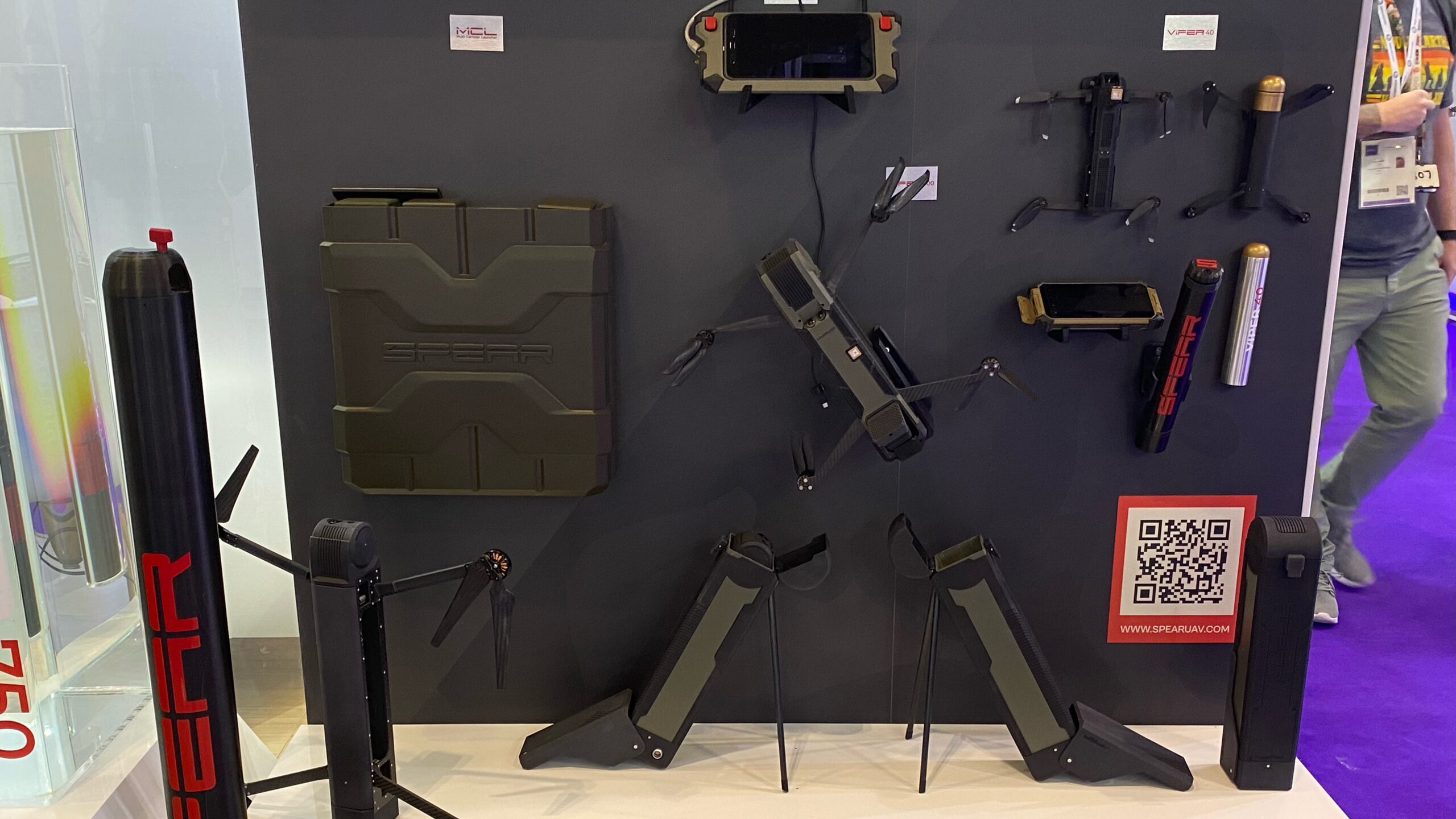
Israeli firm SpearUAV displays its multi-canister launch system at DSEI 2023. (Justin Katz / Breaking Defense)
DSEI 2023 — From new VTOL offerings to novel combinations of existing platforms, multiple Israeli defense firms took the opportunity at DSEI in London this year to show of their latest wares, including one firm whose senior official told Breaking Defense is looking for its niche in giving “maneuvering forces” a new attack option.
Yiftach Kleinman, executive vice-president at SpearUAV, recently joined the company from Israel’s much larger Rafael Advanced Defense Systems. At Rafael he worked on the company’s Trophy active defense system — knowledge he hopes to take to turn SpearUAV from a “small business to big business.” To do so, Kleinman is aiming at a relatively small target, for now.
“A lot of players build drones for infantry, but there isn’t a company that provides a solution for maneuvering forces,” he told Breaking Defense. SpearUAV produces drones stored inside a capsule so that they can be mounted on vehicles, as well as naval assets, such as submarines and launched on the go.
FULL COVERAGE: Breaking Defense at DSEI 2023 in London
Timed for the DSEI expo, SpearUAV unveiled a multi-canister launcher (MCL), capable of being vehicle-mounted, for its Viper 300 UAV. Though the company has different sized platforms, it said the model can carry a 300-gram payload, including a warhead that size. The UAV system uses artificial intelligence to “distinguish between non-relevant and relevant targets,” Kleinman said, describing it as “part of our inhouse capabilities.”
Traditionally used for surveillance-related missions, Kleinman said that the ability to use these systems to attack is new, and he said the system has gone through a directional warhead “qualification process” with an unnamed customer. “This is the breakthrough we have been through in the last three months. For many years Spear was perceived as more of an ISR company and here we show the ability to attack,” he said.
The multi-canister launcher is meant to make the capability relatively easy to fit on a vehicle, where a unit will have to balance good size, weight and power (SWAP) such that the operator gets more bang for the size of real estate the system takes up. The multiple-launch system also allows, for instance, for multiple drones to be launched so one can conduct surveillance for up to 30 minutes, while a loitering munition is then sent to strike a target.
RELATED: With ‘Black Recon,’ Teledyne FLIR offers small, vehicle-launched spy drones
A presentation from SpearUAV showed an example of the system mounted on a Boxer armored fighting vehicle. In this configuration several capsules on the turret can launch drones that might include different payloads, such as one with ISR capabilities, one with EW and one with a munition, Kleinman said. It could also be mounted on unmanned ground vehicles.
The company did not specify any current procurement phases it is part of, but Kleinman said the company is “in stages of integrating our MCL to their platforms. We are in the delivery phase to customers.”
Other Israeli firms highlighted different unique ideas elsewhere at DSEI. Elbit, for instance, promoted not a new platform, but a new way to use two existing ones, the Skylark III and SkyStriker Loitering Munition. The Skylark III is an intelligence-gathering drone that can fly for up to 18 hours, Elbit says, while SkyStriker is a loitering munition with a 10-kilogram warhead that can fly for two hours up to 100 kilometers. Elbit has taken the two and combined them with what they call the “FAST [find and strike] Capsule,” where they can both be stored, carried, launched, operated and controlled by the same equipment and by the same crew,” the company said.
RELATED: UK official says no ‘definitive’ timeline to decide Saudi involvement in GCAP future fighter
The drones are both launched from a “pneumatic” launcher, or a kind of catapult, and both “can be assigned to the same mission simultaneously managed by a shared Ground Control Station.” The idea is for one to do the spotting and the other do the attacking, without the normal complication that usually comes with using two different unmanned systems at the same time.
Israeli defense giant IAI, meanwhile, unveiled a new unmanned system at DSEI called Rotem Alpha, a new vertical takeoff and landing loitering munition. It’s designed, the company said, for anti-tank missions specifically. The company says the system is man-portable.
“Rotem Alpha’s sensor suite autonomously detects and locates hostile enemy fires, like artillery, rockets, and missile launchers, and then investigates and engages a direct attack using its electro-optical day and night seeker,” the company said in a statement announcing the drone.






















